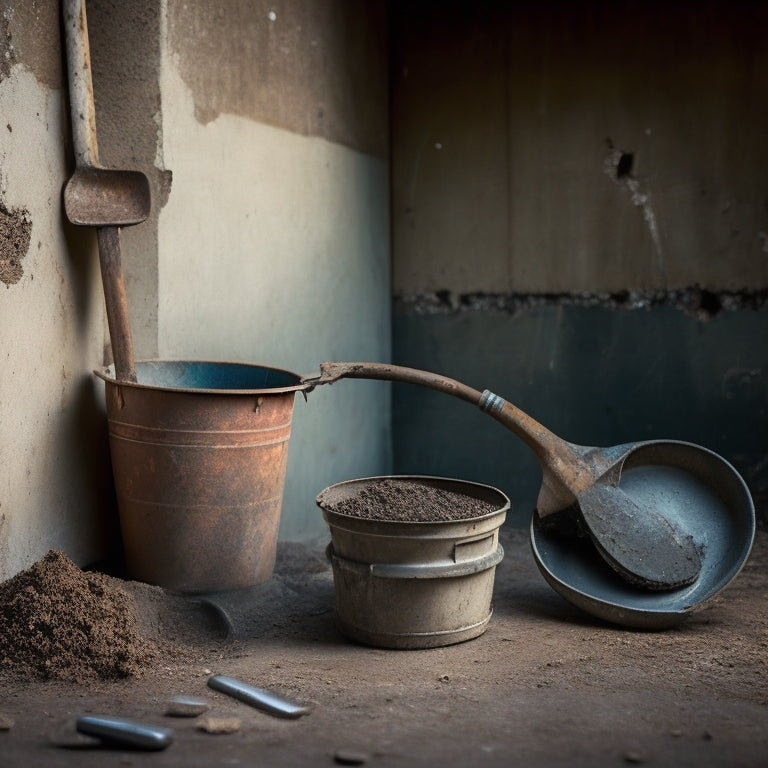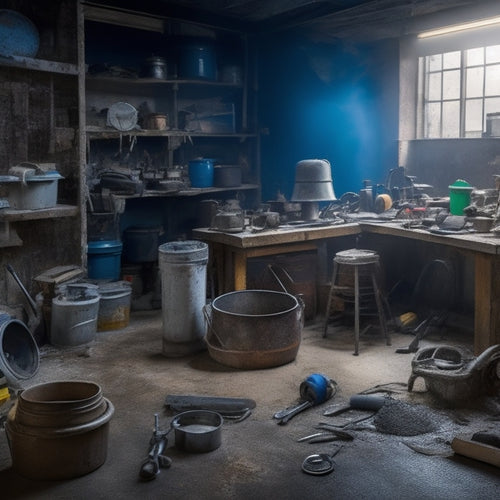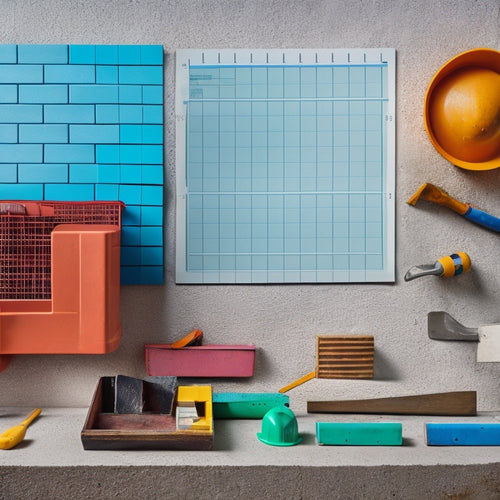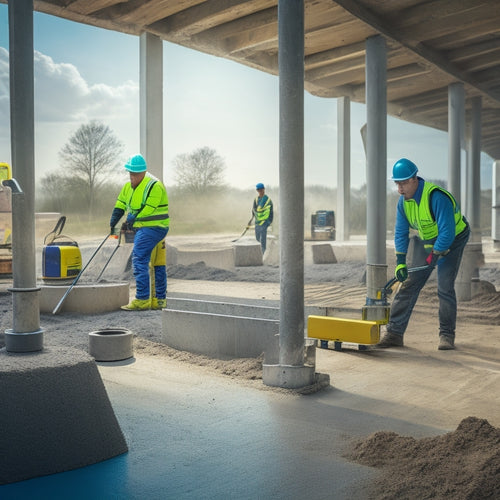
Why You Need the Right Concrete Wall Tools
Share
You'll greatly increase the risk of structural weaknesses, costly rework, and even safety hazards if you don't equip yourself with the right concrete wall tools and techniques. From mixing and tamping to finishing and curing, every step requires specialized tools for uniform consistency, precise measurement, and effective compaction. Without them, you'll face compromised walls, uneven finishes, and potential failures. By investing in the right tools and mastering their use, you'll guarantee a strong, stable, and aesthetically pleasing concrete wall that meets project requirements and exceeds expectations - and discovering the details of each step will reveal the full potential of your project.
Key Takeaways
• Selecting the right concrete mix and ratio is crucial to ensure the wall meets required standards and specifications.
• Having the right mixing tools, such as drum mixers and tamping rods, ensures uniform consistency and strong finishes.
• Proper tamping and compacting tools remove air pockets and excess water, creating a solid foundation capable of supporting heavy loads.
• Finishing tools, like float trowels and steel trowels, are necessary for achieving a smooth, even surface, and mastering trowel techniques is critical.
• Using the right measuring and alignment techniques, such as measuring and marking, wall elevation checks, and plumb line verification, ensures a structurally sound and visually appealing finish.
Choosing the Right Concrete Mix
When constructing a concrete wall, you must select a concrete mix that matches your project's specific requirements, as the wrong mix can lead to structural weaknesses, cracked surfaces, or even collapse.
There are several concrete types to choose from, each with its unique characteristics and applications. For instance, normal-strength concrete is suitable for general construction, while high-strength concrete is ideal for heavy-duty applications.
You must also consider the mix ratios, which can greatly impact the concrete's performance. A mix ratio of 1:2:3 (cement:sand:aggregate) is commonly used for general construction, but you may need to adjust it based on your project's specific needs.
For example, a higher cement content may be required for high-strength applications, while a lower cement content may be suitable for decorative concrete.
By understanding the different concrete types and mix ratios, you can guarantee that your concrete wall meets the required standards and specifications.
Essential Tools for Concrete Mixing
Your concrete mixing arsenal should include a range of essential tools to guarantee efficient and accurate batching, mixing, and placement of the concrete. A high-quality mixer is the foundation of your mixing arsenal, and you'll need to choose the right type for your specific needs. Drum mixers, for instance, are ideal for large batches, while portable mixers are perfect for small to medium-sized projects. You'll also need a range of mixing tools, such as tamping rods, mixing sticks, and shovels, to guarantee thorough mixing and uniform consistency.
Mastering various mixing techniques is vital to achieving the perfect mix. You'll need to know how to mix correctly, whether you're using a dry-mix or wet-mix method. Additionally, understanding the different mixer types and their applications will help you optimize your mixing process.
Don't forget to invest in safety gear, such as gloves and safety glasses, to protect yourself from the physical demands of mixing concrete. With the right tools and techniques, you'll be well on your way to producing high-quality concrete that meets your project's requirements.
Measuring and Marking Concrete Walls
Measuring and marking concrete walls accurately is vital to guaranteeing a structurally sound and visually appealing finish, as even slight miscalculations can lead to costly rework and compromised integrity.
When you're working with concrete, precision is key, and that starts with accurate measurements. You'll need to take precise readings to guarantee that your walls are level, plumb, and square.
To achieve measurement accuracy, you'll need to employ the right marking techniques. Here are three significant considerations to keep in mind:
-
Use a high-quality level: A level guarantees that your walls are perfectly horizontal or vertical, which is critical for structural integrity and aesthetic appeal.
-
Select the right marking tools: Chalk lines, laser levels, and precision markers are all essential for making accurate marks on your concrete walls.
-
Double-check your measurements: Verify your readings multiple times to catch any potential errors before they become costly mistakes.
Tamping and Compacting Concrete
As you prepare to lay the concrete, tamping and compacting the mixture becomes vital to remove air pockets and excess water, guaranteeing a strong, durable, and even finish.
You'll need to employ effective tamping techniques to eliminate air pockets and prevent weaknesses in the concrete. This involves using a tamper or a vibrating plate compactor to apply pressure to the mixture, forcing air bubbles to the surface.
Next, you'll need to compact the concrete using compacting methods that guarantee uniform density throughout the slab. This can be achieved through the use of hand tampers, plate compactors, or roller compactors, depending on the size and scope of your project.
It's essential to compact the concrete in sections, working in a consistent pattern to avoid creating unevenness. By tamping and compacting the concrete correctly, you'll achieve a solid foundation that can support heavy loads and withstand environmental stresses.
Finishing Tools for Smooth Walls
With the concrete compacted and leveled, you're ready to focus on achieving a smooth, even finish using specialized finishing tools. This is where the magic happens, and your wall starts to take shape. To get the desired finish, you'll need to master various trowel techniques, from applying the initial layer to making the final finishing touches.
Here are three essential finishing tools you shouldn't skip:
-
Float trowel: For applying and spreading the concrete evenly, ensuring a smooth surface.
-
Steel trowel: For making the final finishing touches, removing excess material, and achieving a high-gloss finish.
-
Edger: For creating clean, defined edges and corners, giving your wall a professional look.
Safety Gear for Concrete Work
You must prioritize wearing the right safety gear when working with concrete to protect yourself from potential hazards and injuries. Concrete work can be hazardous, and neglecting safety protocols can lead to serious consequences. As you work with concrete, you're exposed to dust, noise, and heavy materials, which can cause respiratory issues, hearing loss, and physical harm.
To guarantee personal protection, you need to wear the right gear. Start with a dust mask or respirator to filter out concrete dust and silica particles. Safety glasses or goggles will protect your eyes from debris and chemical splashes. Wear earplugs or earmuffs to reduce noise exposure.
Steel-toed boots, gloves, and a hard hat will protect your feet, hands, and head from impact and crushing injuries. Don't forget to wear a long-sleeved shirt, pants, and a dust-resistant jacket to prevent skin irritation and abrasion.
Concrete Cutting and Demolition
Concrete cutting and demolition tools are designed to efficiently disintegrate and remove existing concrete structures, requiring precision and control to avoid damaging surrounding materials or compromising safety.
As you commence on a concrete project, you'll need the right tools to execute demolition techniques with finesse. Here are three essential tools to master concrete cutting and demolition:
-
Concrete saws: These powerful machines are designed to cut through concrete with ease, making them an important tool for demolition. Choose from gas-powered, electric, or hydraulic saws, each with its unique advantages.
-
Demolition hammers: These heavy-duty tools deliver high-impact blows to disintegrate concrete, making them perfect for breaking up thick slabs or foundations.
-
Jackhammers: With their rapid hammering action, jackhammers are ideal for breaking up concrete floors, sidewalks, or driveways.
When selecting concrete cutting and demolition tools, consider the scale and complexity of your project. By investing in the right equipment, you'll guarantee efficient and safe demolition, paving the way for a successful concrete project.
Formwork and Molding Tools
Forming and shaping fresh concrete into precise structures requires a range of specialized tools, including formwork and molding equipment designed to guarantee accurate, consistent results.
You'll need to select the right formwork materials for your project, considering factors like durability, strength, and surface finish. This might include steel, aluminum, or wood forms, each with its own advantages and limitations.
When it comes to molding techniques, you'll want to master the art of creating smooth, even surfaces. This involves precision-crafted molding tools that can produce high-quality finishes, from simple curves to complex geometries.
You'll need to choose the right molding techniques for your specific project, whether it's slipforming, gang forming, or hand molding.
Leveling and Aligning Walls
When you're building a concrete wall, ensuring it's level and aligned is essential.
You'll need to perform wall elevation checks to confirm the wall's height is consistent,
verify the plumb line to guarantee it's perfectly vertical,
and use a straightedge to align the wall's edges.
Wall Elevation Checks
You'll need to perform wall elevation checks to confirm your walls are level and aligned, as even slight deviations can compromise the structural integrity of the entire building. This vital step guarantees that your walls can withstand various loads and stresses, maintaining the overall wall stability assessment.
During the wall elevation checks, you'll need to verify that the walls are plumb, level, and aligned with the design specifications. This structural integrity evaluation is essential, as any discrepancies can lead to costly rework, safety hazards, or even catastrophic failures.
Here are three important reasons why wall elevation checks are necessary:
-
Prevents Structural Failures: Wall elevation checks help identify potential structural weaknesses, confirming that your walls can support the intended loads and stresses.
-
Saves Time and Money: By catching deviations early, you can avoid costly rework and project delays, maintaining your project's timeline and budget.
-
Guarantees Safety: Level and aligned walls are less prone to collapse, confirming the safety of construction workers, occupants, and bystanders.
Plumb Line Verification
To make sure accurate wall elevation checks, you must verify the plumb line, which involves leveling and aligning walls to confirm they're perfectly vertical and straight. This significant step guarantees plumb line accuracy, which is critical for structural integrity and aesthetic appeal. Any deviation from vertical alignment can lead to costly rework, compromised safety, and diminished wall quality.
To achieve precise plumb line verification, follow these guidelines:
| Verification Method | Description |
|---|---|
| Laser Level | Projects a level line onto the wall, ensuring accurate vertical alignment |
| String Line | Creates a taut string line to guide wall construction and verify plumbness |
| Digital Level | Provides precise angle measurements to detect even slight deviations |
| Plumb Bob | Uses gravity to determine true vertical alignment |
Straightedge Alignment
With the plumb line verified, you're ready to align the wall using a precision straightedge, making certain the entire wall surface is leveled and aligned to perfection. This critical step requires attention to detail and the right tools.
You'll need to choose the appropriate straightedge type, such as a laser straightedge or a traditional straightedge, depending on the wall's size and complexity.
To achieve precise alignment, employ advanced alignment techniques, including:
-
Dual-axis alignment: Make sure the straightedge is aligned with both the X and Y axes to guarantee a perfectly level and plumb wall.
-
Incremental alignment: Divide the wall into smaller sections and align each one incrementally, maintaining precision and control.
-
Reference point alignment: Establish a fixed reference point and align the straightedge to it, making certain consistent and accurate results.
Cleaning and Curing Concrete Walls
When you're working with concrete walls, you'll need to clean them properly to guarantee a strong finish.
You'll want to remove dirt and debris, apply curing compounds, and maintain ideal conditions to prevent defects.
Remove Dirt and Debris
Remove dirt and debris from the concrete wall's surface by sweeping or blowing it away, as any remaining particles can interfere with subsequent finishing operations.
You'll want to guarantee the surface is clean and free of obstructions to achieve a smooth, even finish.
Dirt removal and debris management are vital steps in preparing your concrete wall for the next stages of construction.
Here are three important reasons why dirt and debris removal is essential:
-
Prevents Bonding Issues: Dirt and debris can prevent adhesives and coatings from bonding properly to the concrete surface, leading to weak spots and potential failures.
-
Guarantees Even Finishing: A clean surface allows for even application of finishing materials, such as paints, coatings, and textures, resulting in a professional-looking finish.
-
Reduces Risk of Defects: Failing to remove dirt and debris can lead to defects, such as cracks, blisters, and delamination, which can compromise the structural integrity of your concrete wall.
Apply Curing Compounds
You'll apply curing compounds to the clean concrete wall surface to prevent moisture loss and promote proper hydration, guaranteeing the concrete achieves its full strength and durability. This important step in concrete wall construction requires attention to detail and the right techniques.
Curing compounds can be applied using various methods, including spraying, rolling, or brushing. It's critical to choose the right application method for your specific project, as it can affect the compound's effectiveness.
When selecting a curing compound, consider factors such as the type of concrete, ambient temperature, and humidity. Some compounds are designed for specific curing techniques, such as membrane-forming or penetrating sealers. Others may be better suited for extreme weather conditions or specialized applications.
Regardless of the product, it's imperative to follow the manufacturer's instructions and apply the compound uniformly to guarantee consistent results.
Maintain Optimal Conditions
Your concrete wall's ideal strength and durability hinge on maintaining a clean surface and controlling environmental factors during the curing process. Failing to do so can lead to subpar results, making it vital to prioritize peak conditions.
To guarantee your concrete wall reaches its full potential, you must:
-
Monitor temperature: Maintain a perfect temperature between 50°F and 75°F (10°C and 24°C) to facilitate proper curing.
-
Control moisture: Regulate moisture levels to prevent excessive drying or water accumulation, which can cause cracks and weaknesses.
-
Prevent contamination: Keep the surface clean and free from debris, oil, and other substances that can compromise the curing process.
Frequently Asked Questions
How Often Should I Maintain My Concrete Wall Tools?
You should prioritize tool maintenance to guarantee peak performance and extend the lifespan of your concrete wall tools.
The maintenance frequency depends on usage; for heavy-duty tools, inspect and clean them daily, while occasional-use tools can be maintained weekly.
Regularly check for wear and tear, lubricate moving parts, and sharpen cutting edges to prevent damage and maintain efficiency.
Can I Use Concrete Wall Tools for Other Construction Projects?
You're a master chef, and your concrete wall tools are your secret ingredients.
Can you use them for other construction projects? Absolutely!
Your tools are more versatile than you think. They can be used for alternative purposes, like building retaining walls, creating decorative features, or even laying foundation slabs.
Their tool versatility knows no bounds, and with a little creativity, you can whip up a construction masterpiece.
What Is the Average Cost of Concrete Wall Tools for a Small Project?
When budgeting for a small concrete wall project, you'll likely spend between $500 to $2,000 on tools, depending on the quality and brand.
A cost comparison reveals that high-end tools may be 2-3 times more expensive, but they'll last longer and provide better results.
You get what you pay for, so prioritize tool quality over cost to guarantee a successful project.
How Do I Store Concrete Wall Tools When Not in Use?
When you're not using your concrete wall tools, proper storage is essential to maintain their condition and extend their lifespan.
You'll want to invest in a tool organization system that keeps your equipment organized, protected, and easily accessible.
Consider storage solutions like toolboxes, chests, or pegboards specifically designed for concrete wall tools.
This will save you time and frustration when you need to find a particular tool for your next project.
Can I Rent Concrete Wall Tools Instead of Buying Them?
You're considering renting concrete wall tools instead of buying them. This approach has its benefits, as you'll avoid storage hassles and upfront costs.
Renting vs buying ultimately depends on your project frequency and scale. If you only need specialized tools occasionally, renting might be the way to go.
However, if you're a frequent user, buying may be more cost-effective in the long run.
Weigh your options carefully to make an informed decision.
Conclusion
As you step back to admire your finished concrete wall, the smooth surface glistens like polished stone, a demonstration of your attention to detail and mastery of the right tools.
The satisfying thud of a well-tamped pour still echoes in your mind, and the precision of your measurements shines like a beacon in the finished product.
With the right concrete wall tools, you've transformed raw materials into a work of art, a sturdy foundation that will stand the test of time.
Related Posts
-

7 Tools to Fix Damaged Concrete Floors
You're about to tackle that damaged concrete floor, and the right tools are essential for a successful repair. Start ...
-

Reinforcement Tools Checklist for Concrete Block Walls
You'll need a range of reinforcement materials, including horizontal and vertical rebar, fiber mesh, and anchor bolts...
-

What Tools Ensure Precise Concrete Leveling Results
You need a range of specialized tools to achieve precise concrete leveling results. Laser leveling instruments provid...


